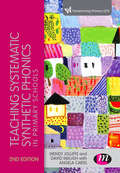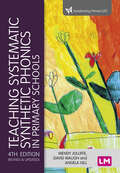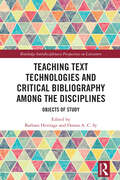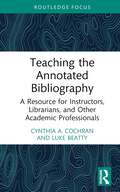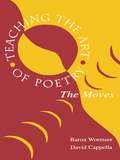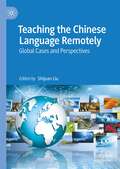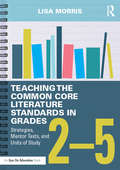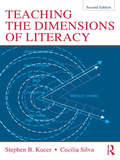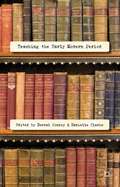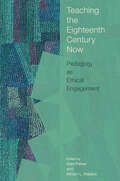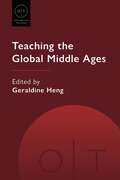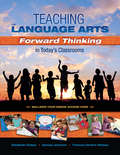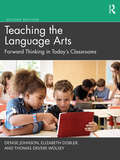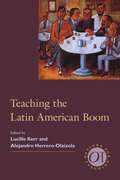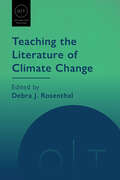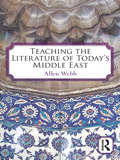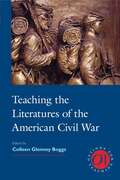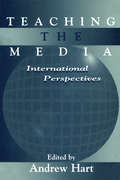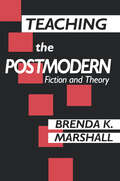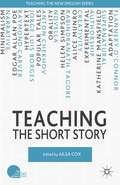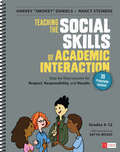- Table View
- List View
Teaching Systematic Synthetic Phonics in Primary Schools (Transforming Primary QTS Series)
by David Waugh Angela Carss Wendy JolliffeThe government prioritizes systematic synthetic phonics as a key strategy in the teaching of reading and this text supports trainee teachers working towards primary QTS in how to use phonics effectively. The text begins by examining the central role of phonics in the teaching of reading, drawing on recent research and initiatives. It goes on to cover the essential knowledge trainees need to acquire themselves for the teaching of phonics to children. Accessible and relevant, the text uses case studies and useful research to support trainees in becoming competent and confident in the teaching of phonics. Supplement this text with the companion audit and test book: Teaching Systematic Synthetic Phonics Audit and Test About the Transforming Primary QTS series This series reflects the new creative way schools are begining to teach, taking a fresh approach to supporting trainees as they work towards primary QTS. Titles provide fully up to date resources focused on teaching a more integrated and inclusive curriculum, and texts draw out meaningful and explicit cross curricular links.
Teaching Systematic Synthetic Phonics in Primary Schools (Transforming Primary QTS Series)
by David Waugh Wendy Jolliffe Angela GillThe government prioritizes systematic synthetic phonics as a key strategy in the teaching of reading. This core text is your guide to teaching systematic synthetic phonics in primary schools. The book′s balance of research and practice and its focused approach enables you to develop an in-depth understanding of what works in phonics teaching, and why. It begins with the subject knowledge that underpins effective teaching and goes on to explore pedagogy from the early years to Key Stage 2. It includes guidance on systematic progression, intervention and multi-sensory and interactive methods. This 4th edition includes a new section ′Challenges in learning and teaching phonics′ supporting you to meet the individual needs of children.
Teaching Systematic Synthetic Phonics in Primary Schools (Transforming Primary QTS Series)
by David Waugh Wendy Jolliffe Angela GillThe government prioritizes systematic synthetic phonics as a key strategy in the teaching of reading. This core text is your guide to teaching systematic synthetic phonics in primary schools. The book′s balance of research and practice and its focused approach enables you to develop an in-depth understanding of what works in phonics teaching, and why. It begins with the subject knowledge that underpins effective teaching and goes on to explore pedagogy from the early years to Key Stage 2. It includes guidance on systematic progression, intervention and multi-sensory and interactive methods. This 4th edition includes a new section ′Challenges in learning and teaching phonics′ supporting you to meet the individual needs of children.
Teaching Text Technologies and Critical Bibliography Among the Disciplines: Objects of Study (Routledge Interdisciplinary Perspectives on Literature)
by Barbara Heritage Donna A. C. SyTeaching Text Technologies and Critical Bibliography Among the Disciplines: Objects of Study is a richly illustrated volume consisting of 23 methods-based chapters discussing innovative and often experimental approaches to hands-on teaching with material texts. Featuring 47 contributors whose work ranges from digital humanities, librarianship, curation, and conservation to architecture, culinary history, fine art, literary history, and the history of science, the collection builds on new work in the areas of text technologies and critical bibliography—emerging scholarly approaches being embraced in the humanities. The book features established experts in bibliography, the history of the book, manuscript studies, and textual editing, as well as educators and students who are applying new critical bibliographical methods (e.g., Black bibliography) to their pedagogy. The result is a dynamic cross-disciplinary, cross-generational exchange modeling inclusive pedagogies with textual artifacts and illuminating how object-oriented teaching can harness the insights of diverse branches of practice and learning.
Teaching the Annotated Bibliography: A Resource for Instructors, Librarians, and Other Academic Professionals
by Cynthia A. Cochran Luke BeattyThis book informs instructors and librarians about the history, aims, and pedagogical uses of the annotated bibliography. A companion to the authors' Writing the Annotated Bibliography, this text enables instructors to better understand the annotated bibliography not only as a tool for research and composition but also as a valuable pedagogical tool. It provides practical guidance along with assignments, lesson plans, assessment rubrics, and other tools for using annotated bibliographies in effective and nuanced ways. It also contains annotated bibliography samples in APA, MLA, and Chicago styles. This practical book is of great use to instructors of composition and research skills, librarians, curriculum designers, writing center directors, and education professionals.
Teaching the Annotated Bibliography: A Resource for Instructors, Librarians, and Other Academic Professionals
by Cynthia A. Cochran Luke BeattyThis book informs instructors and librarians about the history, aims, and pedagogical uses of the annotated bibliography. A companion to the authors' Writing the Annotated Bibliography, this text enables instructors to better understand the annotated bibliography not only as a tool for research and composition but also as a valuable pedagogical tool. It provides practical guidance along with assignments, lesson plans, assessment rubrics, and other tools for using annotated bibliographies in effective and nuanced ways. It also contains annotated bibliography samples in APA, MLA, and Chicago styles. This practical book is of great use to instructors of composition and research skills, librarians, curriculum designers, writing center directors, and education professionals.
Teaching the Art of Poetry: The Moves
by Baron Wormser A. David CappellaConcise and accessible, this guide to teaching the art of poetry from Shakespeare to contemporary poets enables anyone to learn about how poets approach their art. Teachers can use this book to explore any facet or era of poetry. Any reader can use it as an entryway into the art of poetry. Teaching the Art of Poetry shows poetry as a multi-faceted artistic process rather than a mystery on a pedestal. It demystifies the art of poetry by providing specific historical, social, and aesthetic contexts for each element of the art. It is a nuts-and-bolts approach that encourages teachers and students to work with poetry as a studio art--something to be explored, challenged, assembled and reassembled, imagined, and studied--all the things that an artist does to present poetry as a search for meaning. This book advocates poetry as an essential tool for aesthetic, cultural, and linguistic literacy. It portrays poetry as an art rather than a knowledge base, and methods for integrating the art of poetry into the school curriculum. The authors' intention is not to fill gaps; it is to change how poetry is presented in the classroom, to change how it is taught and how students think about it. Teaching the Art of Poetry: * Emphasizes hands-on experiences. Over 160 exercises focus attention on the dynamics of the art of poetry. Activities include group work, peer editing, critical thinking skills, revising drafts, focused reading, oral communication, listening skills, and vocabulary, as well as mechanics and usage. * Features a week-long lesson plan in each chapter to aid the teacher. These relate the main aspects of each chapter to classroom activities and, in addition, include a "Beyond the Week" section to promote further investigation of the topic. * Promotes an integrated approach to poetry. The examples used in each chapter show poetry as a living tradition. * Makes extensive use of complete poems along with extracts from many others. * Does not talk down to teachers--is teacher oriented and jargon free.
Teaching the Chinese Language Remotely: Global Cases and Perspectives
by Shijuan LiuThis edited book brings together global perspectives and case studies from five continents to provide an international picture of teaching Chinese remotely. It consists of 15 original chapters by 21 authors from 10 countries. Addressing both practice and research, these chapters collectively offer a comprehensive view of how Chinese language courses worldwide were urgently moved to fully online during the early stages of the Covid-19 pandemic.This edited volume reports fresh and first-hand experiences of Chinese language instructors and students in different countries as well as their perceptions of issues regarding remote teaching and learning in an emergency situation.The book will be of interest to Chinese language teachers and students, as well as scholars with a focus on language education and online teaching and learning more broadly.
Teaching the Common Core Literature Standards in Grades 2-5: Strategies, Mentor Texts, and Units of Study
by Lisa MorrisShifting your literature instruction to meet the Common Core can be tricky. The standards are specific about how students should analyze characters, themes, point of view, and more. In this new book, Lisa Morris makes it easy by taking you through the standards and offering tons of practical strategies, tools, and mentor texts for grades 2-5. She shows you how to combine the standards into effective units of study so that you can teach with depth rather than worry about coverage. Topics covered include: Teaching questioning, inferring, and author’s purpose; Guiding readers to look at themes and write summaries; Showing students how to recognize structural elements of literature; Teaching the craft of writing and vocabulary development; and Helping students analyse characters and character development. Throughout this highly practical book, you’ll find a variety of charts and other graphic organizers that can be easily adapted for classroom use. A list of suggested mentor texts is also available as a free eResource from our website, www.routledge.com/books/details/9781138856172.
Teaching the Dimensions of Literacy: A Conceptual Base For The Teaching Of Reading And Writing In School Settings
by Stephen Kucer Cecilia SilvaTeaching the Dimensions of Literacy provides both the conceptual knowledge to support teachers' instructional decisions in the reading/literacy classroom and a multitude of instructional strategy lessons for classroom use with both monolingual and bilingual students. It proposes that teachers need to help children become code breakers (the linguistic dimension), meaning makers (the cognitive dimension), text users and critics (the sociocultural dimension), and scientists (the developmental dimension). Acknowledging and addressing all four dimensions, this text links literacy theory, literacy research, and literacy practice in a useable way. Covering both reading and writing, it features clear, concise, and useable reading and writing strategy lessons and ways to modify them for different types of students. Changes in the Second Edition: Entirely reorganized, the text is more user friendly, builds a stronger link between theory and practice, and makes it is easier for teachers to locate appropriate strategy lessons to use with their students. Academic literacy is addressed more fully.
Teaching the Early Modern Period
by Derval Conroy Danielle ClarkeThis innovative project unites leading scholars of English, History and French to examine the challenges of teaching early modern literature, history and culture within higher education. The volume sets out a variety of approaches to teaching the period and aims to revitalize the connection between teaching and research.
Teaching the Eighteenth Century Now: Pedagogy as Ethical Engagement (Transits: Literature, Thought & Culture, 1650-1850)
by Tiffany Potter Ziona Kocher Kate Parker Teri Doerksen Christine D. Myers Diana Epelbaum Matthew L. Reznicek Travis Chi Lau Emily C. Casey Eugenia ZuroskiIn this timely collection, teacher-scholars of “the long eighteenth century,” a Eurocentric time frame from about 1680 to 1832, consider what teaching means in this historical moment: one of attacks on education, a global contagion, and a reckoning with centuries of trauma experienced by Black, Indigenous, and immigrant peoples. Taking up this challenge, each essay highlights the intellectual labor of the classroom, linking textual and cultural materials that fascinate us as researchers with pedagogical approaches that engage contemporary students. Some essays offer practical models for teaching through editing, sensory experience, dialogue, or collaborative projects. Others reframe familiar texts and topics through contemporary approaches, such as the health humanities, disability studies, and decolonial teaching. Throughout, authors reflect on what it is that we do when we teach—how our pedagogies can be more meaningful, more impactful, and more relevant. Published by Bucknell University Press. Distributed worldwide by Rutgers University Press.
Teaching the Global Middle Ages (Options for Teaching #54)
by Geraldine HengWhile globalization is a modern phenomenon, premodern people were also interconnected in early forms of globalism, sharing merchandise, technology, languages, and stories over long distances. Looking across civilizations, this volume takes a broad view of the Middle Ages in order to foster new habits of thinking and develop a multilayered, critical sense of the past.The essays in this volume reach across disciplinary lines to bring insights from music, theater, religion, ecology, museums, and the history of disease into the literature classroom. The contributors provide guidance on texts such as the Thousand and One Nights, Sunjata, Benjamin of Tudela's Book of Travels, and the Malay Annals and on topics such as hotels, maps, and camels. They propose syllabus recommendations, present numerous digital resources, and offer engaging class activities and discussion questions. Ultimately, they provide tools that will help students evaluate popular representations of the Middle Ages and engage with the dynamics of past, present, and future world relationships.
Teaching the History of the English Language (Options for Teaching #46)
by Colette Moore and Chris C. PalmerThe study of the history of the English language (HEL) encompasses a broad sweep of time and space, reaching back to the fifth century and around the globe. Further, the language has always varied from place to place and continues to evolve today. Instructors face the challenges of teaching this vast subject in one semester and of engaging students with unfamiliar material and techniques. This volume guides instructors in designing an HEL course suited to their own interests and institutions.The essays consider what subjects of HEL to include, how to organize the course, and what textbook to assign. They offer historical approaches and those that are not structured by chronology. Sample assignments provide opportunities for students to conduct original research, work with archives and digital resources, and investigate language in their communities. The essays also help students question notions of linguistic correctness.
Teaching the Italian Renaissance Romance Epic (Options for Teaching #44)
by Jo Ann CavalloThe Italian romance epic of the fifteenth and sixteenth centuries, with its multitude of characters, complex plots, and roots in medieval Carolingian epic and Arthurian chivalric romance, was a form popular with courtly and urban audiences. In the hands of writers such as Boiardo, Ariosto, and Tasso, works of remarkable sophistication that combined high seriousness and low comedy were created. Their works went on to influence Cervantes, Milton, Ronsard, Shakespeare, and Spenser.In this volume instructors will find ideas for teaching the Italian Renaissance romance epic along with its adaptations in film, theater, visual art, and music. An extensive resources section locates primary texts online and lists critical studies, anthologies, and reference works.
Teaching the Language Arts: Forward Thinking in Today's Classrooms
by Elizabeth Dobler Denise Johnson Thomas DeVere WolseyTeaching the Language Arts helps readers envision their future classrooms, including the role technology will play, as they prepare to be effective teachers. The book’s multimedia digital format represents a distinctive way to learn about teaching—combining traditional and electronic content, resources, and pedagogy to create a powerful, interactive experience that encourages active learning. Readers can explore a rich array of teaching tools and experiences, including an effective blend of classroom photographs (taken by the authors during school visits), student samples, podcast interviews with teachers and students, classroom videos, and online resources—all of which allow readers to learn from real-world classrooms. This book’s unique and engaging voice, supported by its multimedia approach, will help future and in-service teachers bring the language arts to life in their own classrooms. Visit the Companion Website at www.routledge.com/cw/dobler for information on accessing the interactive e-book and additional ideas and resources to help you and your students use it to its full potential.
Teaching the Language Arts: Forward Thinking in Today's Classrooms
by Denise Johnson Elizabeth Dobler Thomas DeVere WolseyThis book helps readers envision their future classrooms, including the role technology will play, as they prepare to be successful teachers. Comprehensively updated, the second edition addresses new demands on teaching in traditional and virtual ELA classrooms, and the new ways technology facilitates effective instructional practices. Organized around the receptive language arts—the way learners receive information—and the expressive language arts—the way leaners express ideas—chapters cover all aspects of language arts instruction, including new information on planning and assessment; teaching reading and writing fundamentals; supporting ELLs, dyslexic, and dysgraphic learners; using digital tools; and more. In every chapter, readers can explore a rich array of teaching tools and experiences, which allow readers to learn from real-world classrooms. The eBook+ version includes interactive features and links to the up-to-date Companion Website, with more strategies, and examples of practice and student work. This book’s unique and engaging voice, supported by its many resources, will help future and in-service teachers bring the language arts to life in their own classrooms.
Teaching the Latin American Boom (Options for Teaching #37)
by Lucille Kerr and Alejandro Herrero-OlaizolaIn the decade from the early 1960s to the early 1970s, Latin American authors found themselves writing for a new audience in both Latin America and Spain and in an ideologically charged climate as the Cold War found another focus in the Cuban Revolution. The writers who emerged in this energized cultural moment--among others, Julio Cortázar (Argentina), Guillermo Cabrera Infante (Cuba), José Donoso (Chile), Carlos Fuentes (Mexico), Gabriel García Márquez (Colombia), Manuel Puig (Argentina), and Mario Varas Llosa (Peru)--experimented with narrative forms that sometimes bore a vexed relation to the changing political situations of Latin America.This volume provides a wide range of options for teaching the complexities of the Boom, explores the influence of Boom works and authors, presents different frameworks for thinking about the Boom, proposes ways to approach it in the classroom, and provides resources for selecting materials for courses.
Teaching the Literature of Climate Change (Options for Teaching)
by Debra J. RosenthalOver the past several decades, writers such as Margaret Atwood, Paolo Bacigalupi, Octavia E. Butler, and Kathy Jetn̄il-Kijiner have explored climate change through literature, reflecting current anxieties about humans' impact on the planet. Emphasizing the importance of interdisciplinarity, this volume embraces literature as a means to cultivate students' understanding of the ongoing climate crisis, ethics in times of disaster, and the intrinsic intersectionality of environmental issues.Contributors discuss speculative climate futures, the Anthropocene, postcolonialism, climate anxiety, and the usefulness of storytelling in engaging with catastrophe. The essays offer approaches to teaching interdisciplinary and cross-listed courses, including strategies for team-teaching across disciplines and for building connections between humanities majors and STEM majors. The volume concludes with essays that explore ways to address grief and to contemplate a hopeful future in the face of apocalyptic predictions.
Teaching the Literature of Today's Middle East
by Allen WebbProviding a gateway into the real literature emerging from the Middle East, this book shows teachers how to make the topic authentic, powerful, and relevant. Teaching the Literature of Today’s Middle East:• Introduces teachers to this literature and how to teach it• Brings to the reader a tremendous diversity of teachable texts and materials by Middle Eastern writers • Takes a thematic approach that allows students to understand and engage with the region and address key issues • Includes stories from the author’s own classroom, and shares student insight and reactions• Utilizes contemporary teaching methods, including cultural studies, literary circles, blogs, YouTube, class speakers, and film analysis• Directly and powerfully models how to address controversial issues in the region Written in an open, personal, and engaging style, theoretically informed and academically smart, highly relevant across the field of literacy education, this text offers teachers and teacher-educators a much needed resource for helping students to think deeply and critically about the politics and culture of the Middle East through literary engagements.
Teaching the Literatures of the American Civil War (Options for Teaching #39)
by Colleen Glenney BoggsWhen Abraham Lincoln met Harriet Beecher Stowe in 1863, he reportedly greeted her as "the little woman who wrote the book that started this Great War." To this day, Uncle Tom's Cabin serves as a touchstone for the war. Yet few works have been selected to represent the Civil War's literature, even though historians have filled libraries with books on the war itself.This volume helps teachers address the following questions: What is the relation of canonical works to the multitude of occasional texts that were penned in response to the Civil War, and how can students understand them together? Should an approach to war literature reflect the chronology of historical events or focus instead on thematic clusters, generic forms, and theoretical concerns? How do we introduce students to archival materials that sometimes support, at other times resist, the close reading practices in which they have been trained?Twenty-three essays cover such topics as visiting historical sites to teach the literature, using digital materials, teaching with anthologies; soldiers' dime novels, Confederate women's diaries, songs, speeches; the conflicted theme of treason, and the double-edged theme of brotherhood; how battlefield photographs synthesize fact and fiction; and the roles in the war played by women, by slaves, and by African American troops. A section of the volume provides a wealth of resources for teachers.
Teaching the Media: International Perspectives (Routledge Communication Series)
by Andrew HartIn TEACHING THE MEDIA: INTERNATIONAL PERSPECTIVES Andrew Hart initiates a challenging dialogue about approaches to Media teaching in the major English-speaking nations of the world, including the United States, Canada, the United Kingdom, Australia, and South Africa. By animating actual lessons and the considered views of classroom practitioners, TEACHING THE MEDIA encourages readers to develop new perspectives on Media teaching, to examine approaches that differ from their own, and to reflect critically on their own practices with a view to understanding them more fully and enhancing their effectiveness in the classroom. Based on original research that began in England in the early 1990s, this is the first international comparative study to focus on Media Education in English-speaking countries. It systematically examines classroom strategies for Media teaching in the light of the major theoretical paradigms which have emerged globally over the last 50 years. It analyses the rich diversity of different educational concerns, goals, and classroom practices through a series of national studies of teachers and lessons. As a result, not only do we see how Media is actually taught in range of classroom contexts, but existing models of Media teaching can now be more precisely critiqued and made more accessible for further research and development.
Teaching the Postmodern
by Brenda MarshallFirst published in 1992. Routledge is an imprint of Taylor & Francis, an informa company.
Teaching the Short Story
by Ailsa CoxThe short story is moving from relative neglect to a central position in the curriculum; as a teaching tool, it offers students a route into many complex areas, including critical theory, gender studies, postcolonialism and genre. This book offers a practical guide to the short story in the classroom, covering all these fields and more.
Teaching the Social Skills of Academic Interaction, Grades 4-12: Step-by-Step Lessons for Respect, Responsibility, and Results (Corwin Literacy)
by Smokey Daniels Nancy H. SteinekeNEWS FLASH: A major meta-analysis of 213 studies showed an average 11 percent gain in academic performance for kids receiving explicit social-academic learning instruction. Turns out this "soft stuff" about creating a culture of respect and rapport yields hard and fast gains, and that’s no surprise to collaboration "gurus" Harvey "Smokey" Daniels and Nancy Steineke. Now, these authors share a yearlong plan for helping you build powerful and binding peer-to-peer interactions. The added bonus: Your kids will meet speaking and listening standards, while you score better on classroom-engagement rubrics. Teaching the Social Skills of Academic Interaction taps the instructional power of slides, full-color illustrations, and super succinct directions to teach both the language and the behaviors of working effectively with others. These 35 lessons take your kids on a carefully paced upward spiral of collaboration, with explicit coaching on how to speak, listen, argue, persuade—and get along. Here’s the best part: You model and your students practice these social skills with the content of your curriculum, not in disconnected add-on exercises. For each lesson, there are six to 25 slides that focus on one vital academic-social skill; step-by-step teaching tips are in the lie-flat planning book. The sequence looks mostly like this: The first slides introduce the skill—like being a good partner or arguing both sides of a controversial topic—then explain its value. The next slides help model the skill in action, using whatever curricular topic you happen to be teaching. Now, kids’ active thinking is invited as you co-create strategies to enhance use of the target social-academic skill. Additional slides help kids practice the skill using your curricular content as you monitor and support. Lessons end with a debriefing to solidify new understandings. Any way you look at Teaching the Social Skills of Academic Interaction, it’s a win-win. Your students realize better engagement in curriculum topics, higher performance, and social skills to last a lifetime. That’s really college and career ready! And our schools become safer harbors, where students know one another, respect one another, and learn together. Longtime collaborators themselves, HARVEY "SMOKEY" DANIELS and NANCY STEINEKE have written six books together and are regular co-presenters at all the major literacy conferences. Both are former public school teachers who now work as national consultants, helping schools and districts to create friendly, supportive, and collaborative climates for young people. For an author-led walk-through of Teaching the Social Skills of Academic Interaction, visit https://www.brainshark.com/corwinpress/teachingsocialskills.
